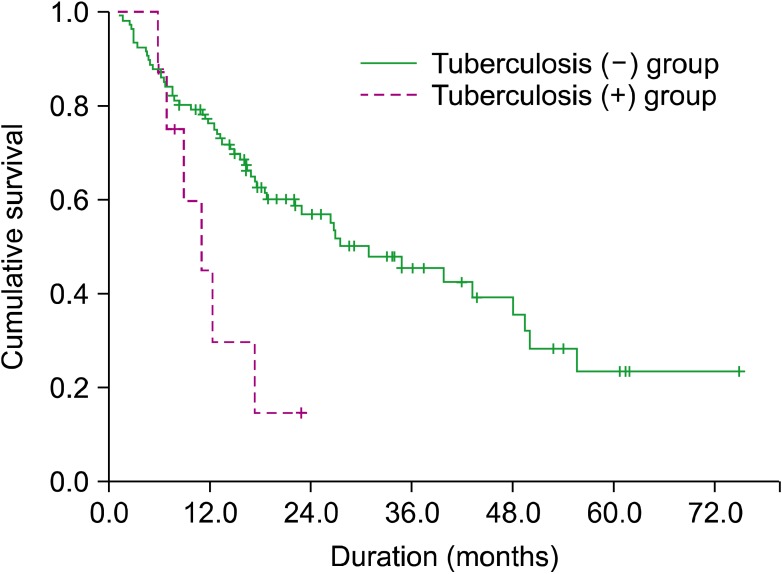Blood Res.
2013 Mar;48(1):35-39. 10.5045/br.2013.48.1.35.
Poor prognostic significance of Mycobacterium tuberculosis infection during bortezomib-containing chemotherapy in patients with multiple myeloma
- Affiliations
-
- 1Department of Hematology-Oncology, Chonnam National University Hwasun Hospital, Hwasun, Korea. drjejung@chonnam.ac.kr
- 2Department of Infectious Disease, Chonnam National University Hwasun Hospital, Hwasun, Korea.
- 3The Brain Korea 21 Project, Center for Biomedical Human Resources at Chonnam National University, Gwangju, Korea.
- KMID: 2270724
- DOI: http://doi.org/10.5045/br.2013.48.1.35
Abstract
- BACKGROUND
Bortezomib administration leads to a transient decrease in CD4+ T cells, increasing the susceptibility to opportunistic infections. The activation and proliferation of CD4+ T cells are particularly important in the host's defense against tuberculosis infection. The aim of this study was to determine the incidence and clinical significance of tuberculosis infection in patients with multiple myeloma (MM) treated with a bortezomib-containing regimen.
METHODS
We retrospectively investigated the incidence of Mycobacterium tuberculosis in 115 patients with MM who were given a bortezomib-containing regimen and studied the disease prognosis.
RESULTS
All patients received chemotherapy prior to bortezomib administration, and the median duration from diagnosis to bortezomib administration was 12.4 months (range, 0.2-230). We diagnosed tuberculosis in 8 patients (8/115, 7%): 7 patients had a pulmonary granulomatous lesion prior to chemotherapy and 1 developed reactivation of tuberculosis, but none of them died of uncontrolled tuberculosis infection. In 50% of patients with tuberculosis, bortezomib-containing therapy was interrupted. This resulted in significantly lower response rates to the bortezomib-containing therapy (P<0.05) and significantly shorter overall survival times amongst tuberculosis vs. non-tuberculosis patients (P=0.017).
CONCLUSION
Tuberculosis infection was not uncommon among the patients with MM who were treated with bortezomib-containing therapy, and tuberculosis infection in these patients resulted in an interruption of bortezomib administration, which significantly affected patient outcomes. Therefore, early diagnosis and treatment of tuberculosis infection are critical to avoid worsening outcomes in such patients.
MeSH Terms
Figure
Reference
-
1. Mazurek GH, Jereb J, Vernon A, LoBue P, Goldberg S, Castro K. Updated guidelines for using interferon gamma release assays to detect mycobacterium tuberculosis infection - United States, 2010. MMWR Recomm Rep. 2010; 59:1–25. PMID: 20577159.2. Dolin PJ, Raviglione MC, Kochi A. Global tuberculosis incidence and mortality during 1990-2000. Bull World Health Organ. 1994; 72:213–220. PMID: 8205640.3. Wu CY, Hu HY, Pu CY, et al. Aerodigestive tract, lung and haematological cancers are risk factors for tuberculosis: an 8-year population-based study. Int J Tuberc Lung Dis. 2011; 15:125–130. PMID: 21276308.4. Ogawara H, Handa H, Yamazaki T, et al. High Th1/Th2 ratio in patients with multiple myeloma. Leuk Res. 2005; 29:135–140. PMID: 15607360.
Article5. Berges C, Haberstock H, Fuchs D, et al. Proteasome inhibition suppresses essential immune functions of human CD4+ T cells. Immunology. 2008; 124:234–246. PMID: 18217957.6. Heider U, Rademacher J, Kaiser M, Kleeberg L, von Metzler I, Sezer O. Decrease in CD4+ T-cell counts in patients with multiple myeloma treated with bortezomib. Clin Lymphoma Myeloma Leuk. 2010; 10:134–137. PMID: 20371447.
Article7. Flynn JL, Chan J. Immunology of tuberculosis. Annu Rev Immunol. 2001; 19:93–129. PMID: 11244032.
Article8. Schütt P, Brandhorst D, Stellberg W, et al. Immune parameters in multiple myeloma patients: influence of treatment and correlation with opportunistic infections. Leuk Lymphoma. 2006; 47:1570–1582. PMID: 16966269.
Article9. Kim YK, Sohn SK, Lee JH, et al. Clinical efficacy of a bortezomib, cyclophosphamide, thalidomide, and dexamethasone (Vel-CTD) regimen in patients with relapsed or refractory multiple myeloma: a phase II study. Ann Hematol. 2010; 89:475–482. PMID: 19921192.
Article10. Rajkumar SV, Harousseau JL, Durie B, et al. Consensus recommendations for the uniform reporting of clinical trials: report of the International Myeloma Workshop Consensus Panel 1. Blood. 2011; 117:4691–4695. PMID: 21292775.
Article11. Schoeman JF, Fieggen G, Seller N, Mendelson M, Hartzenberg B. Intractable intracranial tuberculous infection responsive to thalidomide: report of four cases. J Child Neurol. 2006; 21:301–308. PMID: 16900926.
Article12. Stefan DC, Andronikou S, Freeman N, Schoeman J. Recovery of vision after adjuvant thalidomide in a child with tuberculous meningitis and acute lymphoblastic leukemia. J Child Neurol. 2009; 24:166–169. PMID: 19182153.
Article13. Gori A, Rossi MC, Marchetti G, et al. Clinical and immunological benefit of adjuvant therapy with thalidomide in the treatment of tuberculosis disease. AIDS. 2000; 14:1859–1861. PMID: 10985328.
Article14. Motoyoshi Y, Kaminoda K, Saitoh O, et al. Different mechanisms for anti-tumor effects of low- and high-dose cyclophosphamide. Oncol Rep. 2006; 16:141–146. PMID: 16786137.
Article15. Jick SS, Lieberman ES, Rahman MU, Choi HK. Glucocorticoid use, other associated factors, and the risk of tuberculosis. Arthritis Rheum. 2006; 55:19–26. PMID: 16463407.
Article16. Engelhardt M, Kleber M, Udi J, et al. Consensus statement from European experts on the diagnosis, management, and treatment of multiple myeloma: from standard therapy to novel approaches. Leuk Lymphoma. 2010; 51:1424–1443. PMID: 20509769.
Article17. Fauci AS, Braunwald E, Kasper DL, editors. Harrison's principles of internal medicine. 2008. 17th ed. New York, NY: McGraw-Hill Medical;p. 1006–1020.
- Full Text Links
- Actions
-
Cited
- CITED
-
- Close
- Share
- Similar articles
-
- A Case of Acute Pancreatitis Caused by Bortezomib in a Patient with Multiple Myeloma
- Reversible Heart Failure after Bortezomib Treatment in a Patient with Multiple Myeloma
- Huge Cutaneous Involvement of Multiple Myeloma
- A Case of Cutaneous Plasmacytoma Treated with Bortezomib and Radiotherapy
- Bortezomib-induced Histiocytoid Sweet Syndrome


